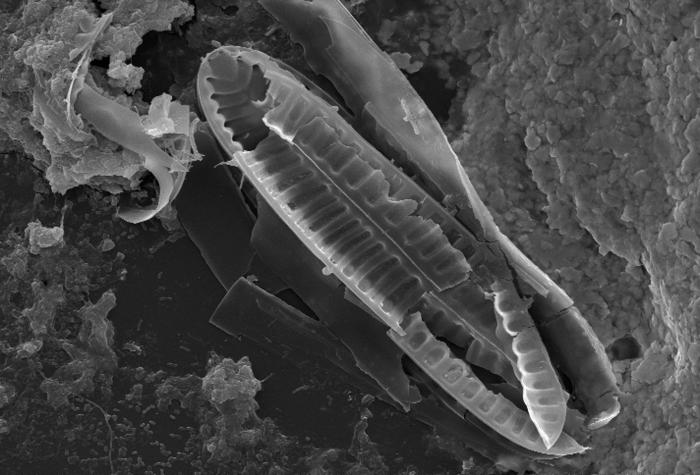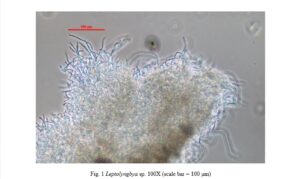? Pass the Mustard
Diatoms

Protected by Glass
WTF!? It Eats Filter Sand???
Uncertain if you have mustard algae or is just sand in the bottom of the pool – BRUSH IT! If it settles back out quickly you are dealing with sand. If it takes several hours to a day or two to resettle, it is mustard algae (aka Diatoms, yellow algae, brown algae).
Get Rid of Mustard Algae video shared with permission from Orenda Technologies
What Do The Pros Say About How to Get Rid of Mustard Algae
“Flock and vac directly out of pool with remote pump.”
“Chlorine ?”
“Brush sides, shock, run pump. Clarifier as needed. Clean filter. Possibly increase daily pump-run time if that was the culprit.”
Depends on if it’s the easy one or the tough one lol. Brushes off easy then just hit it with chlorine and keep it circulating. Tough one use some copper sulfate
“Brush, Add chlorine and clean the filter.”
“We use a sodium bromide treatment followed with super chlorination. Once brushed and filtered, we use enzymes to prevent the return of it.”
“Copper-based algaecide….”
“Sodium Bromide”
CPO Certification Class is available as a 100% Online Class for a limited time, read more www.cpoclass.com
Just Get Rid of It
F**k it, why mess around. A few folks said vac to waste and then treat with chlorine. One or two other specialty chemicals were included in some responses. Sure, why not, If you have the type of Mustard algae that “dusts” upon the floor (keep in mind how many species we said there are) just vacuum it out, boost the chlorine level, and call it a day.
Sodium Bromide
Professor Pool is asked many times and often about the sodium bromide for the yellow algae. This is true, this is one of the go-to items for the modern pool tech when the diatoms invade the pool. But, how exactly does this make the mustard algae go away?
To simplify, chlorine oxidizes sodium bromide resulting in free bromine (hypobromous acid and hypobromite ions). So yes, we need to have a chlorine level in the pool to cause that reaction with the sodium bromide we are adding. Without chlorine already present in the water, the product will not do anything.
Why add it? The answer here is straightforward. Bromine is a better algaecide than chlorine. Just remember, repeated addition of a sodium bromide-based algae treatment in a pool treated with chlorine will result in a bromine pool.
With that, consider that this method is not advised for use with UV, Ozone, or a saltwater generator. Even the UV from the sunlight could lead to the production of the harmful disinfection byproduct Bromate.
For more on the reactions of bromine in pool water, read our article 96,000,000 Black Balls
What About Copper?
Copper is essential to photosynthetic organisms, however, in large amounts, it can prove fatal to algae. The metal is necessary to perform photosynthesis, but in excess amounts will inhibit the process.
Without the ability to synthesize food from CO2 (carbon dioxide) and energy from the sun, the yellow algae, like any photosynthetic organism, will not survive. Copper will also lyse (rupture the cell membrane) the alga. Therefore, the impact of a copper algaecide in the treatment of mustard algae is two-fold, damaging the diatoms from both inside and out.
For more information on using copper as an algaecide, read our article Black Algae Copper Experiment

EDTA + Ammonium Sulfate
Disodiumsalt of ethylenediaminetetraaceticaciddihydratediammoniumsulfate C₁₀H₁₆N₂O₈ WTF?! Okay, but seriously. If you have used Yellow Out or Green to Clean, then you have used this, and you know there are quite a few steps involved. It’s been a couple of decades for me, so if I get the steps slightly off – please correct me below. Besides, for those of you out in the field, you should always read the directions on the label.
- Raise your pH to >8.0
- Add 2 lbs of Yellow Out per 15,000 gallons of water. Broadcast half and pour the rest around the perimeter inside the pool (I have a funny story that goes with this one)
- Immediately Follow behind with an equal dose of chlorine shock (use the appropriate shock for your pool type)
- Run the pump/filter overnight
- Repeat the dose of chlorine shock
Okay. I think that’s pretty close. So, how does this stuff work? We actually have a bunch of different things that are going on here. EDTA is widely known for its antibacterial properties and was/is commonly used in hospitals.
It is a chelating agent and reduces “shmear adhesion.” Shmear adhesion is what allows Black algae and some forms of Mustard algae to adhere to pool walls. By reducing this, EDTA serves as a successful anti-biofilm and algastat for any wall clinging algae.
We haven’t even added our dose of chlorine yet
Here is where the magic happens. As this is a salt of EDTA with ammonium sulfate added, there is a reaction with chlorine. First, we see a slow degradation of EDTA due to the oxidizing nature of chlorine. That’s okay, it’s slow, and the EDTA will be around long enough to do its job. The chlorine will also attempt to oxidize the ammonium sulfate as well, resulting in the creation of monochloramine. Yup, we just created chloramines, and that’s a good thing.
Monochloramine is slower at disinfecting than FAC (Free Available Chlorine), so it’s going to last in the pool water a bit longer. It has no attraction to Cyanuric Acid whatsoever, so those bonds in high CyA levels that impede the effectiveness of FAC are no longer a factor. Monochloramine (are you sitting down?) is simply a better algaecide than FAC. So, as I mentioned above, this product in these combinations provide us with a whole lot of algae killing goodness.
The Funny Yellow Out Story
This one goes waaaaayyyyy back. It was 1992, I was one year into the pool industry and actually had hair. It’s a busy day at the water test station, there was a constant line maybe a dozen deep. A woman approaches once it becomes her turn and hands me a ziplock bag full of water (I can’t tell you how much I hated water tests in those stupid bags).
She tells me that she has already been to two other pool stores and has spent hundreds of dollars only to have her pool remain green. Of course, there was also a sense of urgency because she was “Having a party on Saturday”.
Okay, why screw around. I recommend Yellow Out. It hadn’t failed me yet at a green to clean. I write down all the steps, just as I had explained above. I show her the instructions on the back of the cylindrical container, and as there are a few steps, I go through them with her twice.
Two days pass and nothing. On the third day, Friday, she enters the store, livid and with a baggie in hand. She waits in line steaming until she gets to the test station and lets me have it. Her pool is still green. After she calms down, I as her to tell me step by step what she did. You’ll get more accurate info this way because if you ask questions, you’ll find out very quickly that people lie.
She details what she had done step by step, and it matches my instructions to the Tee. I’m scratching my head, and she is still angry. I ask her to repeat her actions once again, and again her words mirror my instructions, but this time she adds, “And now what am I supposed to do with all the chemicals I poured onto the deck?” Wait. What? You see, in my instruction on how to add the yellow out (step number 2 above) I did not include the portion I have in purple up top. So when she broadcast half the dose accross the pools surface and poured the remainder around the perimeter of the pool, I’m afraid that is exactly what she had done.
The portion in purple has been in my instructions ever since.
What’s Your Mustard Algae Go To?
| Want to talk about things like this and more? Join our group on Facebook ?? | |||||||
|
|||||||







